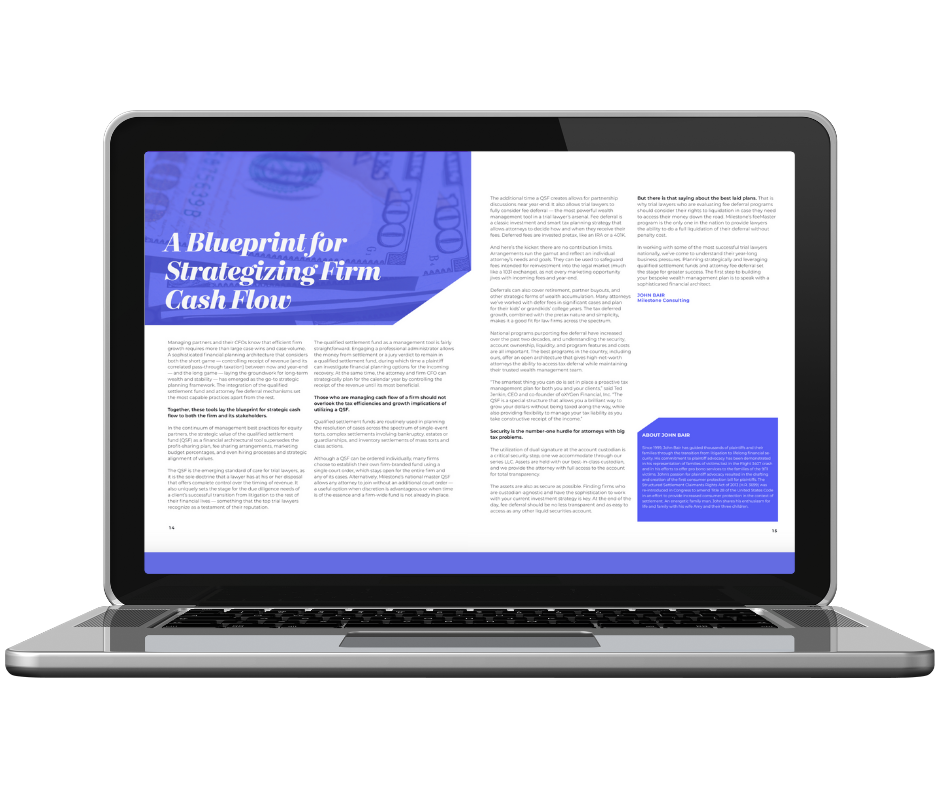By John Bair, originally published on crispvideo.com
Managing partners and their CFOs know that efficient firm growth requires more than large case wins and case volume. A sophisticated financial planning architecture that considers both the short game – planning for revenue between now and year-end, and laying the groundwork for long-term wealth and stability, has emerged as the go-to strategic planning framework. The integration of the qualified settlement fund and attorney fee deferral mechanisms set the most capable practices apart from the rest. Together, these tools lay the blueprint for strategic cash flow to both the firm and its stakeholders.
In the continuum of management best practices for equity partners, the strategic value of the qualified settlement fund (QSF) as a financial architectural tool supersedes the profit-sharing plan, fee sharing arrangements, marketing budget percentages, and even hiring processes and strategic alignment of values. The QSF is the emerging standard of care for trial lawyers, as it is the sole doctrine that a lawyer has at his or her disposal that offers complete control over the timing of revenue. It also uniquely sets the stage for the due diligence needs of a client’s successful transition from litigation to the rest of their financial lives – something that the top trial lawyers recognize as a testament of their reputation.
The QSF as a management tool is fairly straightforward. Engaging a professional administrator allows the money from settlement or a jury verdict to remain in a QSF, during which time a plaintiff can investigate financial planning options for the incoming recovery. At the same time, the attorney and firm CFO can strategically plan for the calendar year by controlling the receipt of the revenue until its most beneficial. Those who are managing cash flow of a firm should not overlook the growth implications of utilizing a QSF.
QSFs are routinely used in planning the resolution of cases across the spectrum of single-event torts, complex settlements involving bankruptcy, estates or guardianships, and inventory settlements of mass torts and class actions. Although a QSF can be ordered individually, many firms choose to establish their own firm-branded fund using a single court order, which stays open for the entire firm and any of its cases.
The additional time a QSF creates allows for partnership discussions near year-end. It also allows trial lawyers to fully consider fee deferral – the most powerful wealth management tool in a trial lawyer’s arsenal. Fee deferral is a classic investment strategy that allows attorneys to decide how and when they receive their fees. Deferred fees are invested pretax, like an IRA or a 401K. And here’s the kicker: there are no contribution limits. Arrangements run the gamut and reflect an individual attorney’s needs and goals. They can be used to safeguard fees intended for reinvestment into the legal market (much like a 1031 exchange), as not every marketing opportunity jives with incoming fees and year-end. Deferrals can also cover retirement, partner buyouts, and other strategic forms of wealth accumulation. Many attorneys we’ve worked with defer fees in significant cases and plan for their kids’ or grandkids’ college years. The tax deferred growth, combined with the pretax nature and simplicity, makes it a good fit for law firms across the spectrum.
“The smartest thing you can do is set in place a proactive tax management plan for both you and your clients,” said Ted Jenkin, CEO and co-founder of oXYGen Financial, Inc. “The QSF is a special structure that allows you a brilliant way to grow your dollars without being taxed along the way while also providing flexibility to manage your tax liability as you take constructive receipt of the income.”
There is that saying about the best laid plans. That is why trial lawyers who are evaluating fee deferral programs should consider their rights to liquidation in case they need to access their money down the road.
In working with some of the most successful trial lawyers nationally, we’ve come to understand their year-long business pressures. Planning strategically and leveraging QSFs and attorney fee deferral set the stage for greater success. The first step to building your bespoke wealth management plan is to speak with a sophisticated financial advisor.


